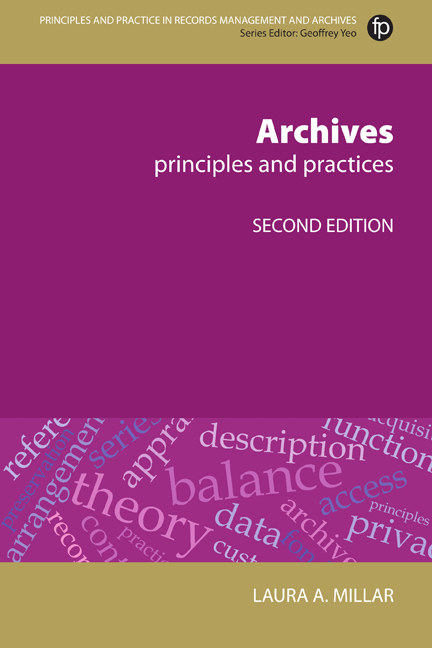Book contents
- Frontmatter
- Contents
- Figures and tables
- Foreword to the first edition
- Foreword to the second edition
- Acknowledgements
- Introduction to the second edition
- PART I ARCHIVAL PRINCIPLES
- PART II ARCHIVAL PRACTICES
- 8 Managing the institution
- 9 Preserving archives
- 10 Acquiring archives
- 11 Arranging and describing archives
- 12 Making archives available
- Conclusion
- To learn more
- Glossary of terms
- Index
- Miscellaneous Endmatter
12 - Making archives available
from PART II - ARCHIVAL PRACTICES
Published online by Cambridge University Press: 08 June 2018
- Frontmatter
- Contents
- Figures and tables
- Foreword to the first edition
- Foreword to the second edition
- Acknowledgements
- Introduction to the second edition
- PART I ARCHIVAL PRINCIPLES
- PART II ARCHIVAL PRACTICES
- 8 Managing the institution
- 9 Preserving archives
- 10 Acquiring archives
- 11 Arranging and describing archives
- 12 Making archives available
- Conclusion
- To learn more
- Glossary of terms
- Index
- Miscellaneous Endmatter
Summary
To oblige persons often costs little and helps much.
Baltasar Gracian (1601–58) The Art of Worldly Wisdom, 1647Finally, we have reached what some consider the ultimate archival activity: making archives available for use. Once the archivist has acquired, arranged and described archival materials, and stored them so they are safe from harm, she can, and should, open the doors and invite the public in.
Traditionally, that is what archivists did. They opened the doors and invited the public, or a select few, into a reference room, where the users sat, in scholarly silence, waiting for boxes and folders to emerge, like treasures on a platter, from the storage vaults. The medieval archivist in the heart of England did not cart the town's archival treasures around in a wagon and set up roadside exhibits of scrolls and parchments. Original archival materials were kept in locked containers, brought out for the privileged few who were permitted access to the archival sanctum sanctorum.
Today, when people can access information through the internet 24 hours a day, archivists still preserve and protect physical, tangible goods, not only paper archives or audiovisual recordings or photographs but also very physical and very expensive computer servers and storage devices used to store and make available irreplaceable electronic archives. But while the physical space for holding archives will not go away, people no longer have to go to the archival reference room for answers to all their questions. Not every item in archival custody will ever be digitized, and helping the researcher in person will still be necessary and valuable, but archivists can make more and more information available online, through databases, websites, digital information networks and social media.
But while computers have made the act of gaining access easier, they have made the process of providing it much harder. The archivist today faces the challenge of balancing access and privacy, respecting individual rights and protecting both physical and digital holdings from loss or harm, problems which were much easier to manage when everyone wanting access stood in line in front of a reference desk.
- Type
- Chapter
- Information
- ArchivesPrinciples and Practices, pp. 243 - 262Publisher: FacetPrint publication year: 2017



